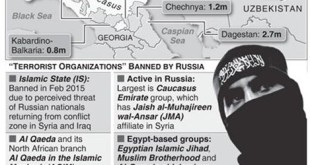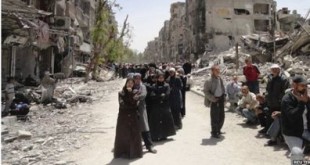 Following the re-election of Barack Obama in last week’s US presidential poll, Washington and its allies have stepped up their war drive against Syria. In the most serious escalation of the 20-month conflict in the Middle East country, the Israeli armed forces fired a missile into Syrian territory Sunday.
Following the re-election of Barack Obama in last week’s US presidential poll, Washington and its allies have stepped up their war drive against Syria. In the most serious escalation of the 20-month conflict in the Middle East country, the Israeli armed forces fired a missile into Syrian territory Sunday.
The strike, by an advanced Tammuz guided missile, is the first acknowledged attack by the Israeli Defense Forces (IDF) on Syria since the 1973 Yom Kippur War. Israeli warplanes struck the site of an alleged Syrian nuclear project in 2007, but neither regime ever officially confirmed the action.
The Israeli missile reportedly struck a Syrian army base, though the government in Damascus has not released any details of the damage caused.
The IDF strike was reportedly carried out in response to a Syrian mortar that landed in the Golan Heights, the Syrian territory illegally occupied by Israel since 1967. Nobody was reported killed or injured by what appears to have been a misdirected 120mm Syrian tank shell.
A statement issued by the IDF shortly after the Tammuz missile struck Syrian territory claimed, “IDF forces fired warning shots and relayed a message to the Syrian forces via the United Nations that warns against additional fire. Additional fire will prompt a quick response.”
The IDF acknowledged that eight Syrian shells had fallen within the Israeli-controlled section of the Golan Heights over the past two months, likely the inadvertent result of fighting between Syrian government forces and “rebel” fighters, without any military response from the IDF.
While Israel appears to have turned a blind eye to errant Syrian shells in the weeks leading up to the US election, the decision by the IDF to launch a strike now indicates that Washington and its allies are entering into a new phase of their conflict with the government of President Bashar al-Assad.
Further evidence of a shift toward open conflict between the major powers and the Syrian regime was provided by General Sir David Richards, Britain’s Chief of the Defence Staff, who on Sunday revealed to the BBC that plans were in place for a military intervention by British forces into Syria.
General Richards told BBC television’s Andrew Marr Show that he expected the humanitarian crisis in Syria to worsen over the winter, which would increase pressure to “intervene in a limited way.”
“Obviously we develop contingency plans to look at all these things. It is my job to make sure that these options are continually brushed over to make sure that we can deliver them and they are credible,” Gen. Richards revealed.
While the UK’s top soldier couched his comments in “humanitarian” language, any invasion of Syrian territory by British and allied forces would be an act of war that would throw Syria and the entire region into even deeper turmoil, threatening to spark military counter-measures by Damascus.
Such a military intervention by Britain and the US, acting with their NATO and Middle Eastern allies, could spark a wider conflict with countries such as Iran, Russia, and China, which have retained close ties to the Assad regime and feel threatened by the explosion of militarist aggression, led by Washington, in the region.
In preparation for such a major offensive against Syria, the Obama administration has initiated a tactical shift away from some of the opposition political forces it has relied upon until now.
Addressing a press conference in Zagreb, Croatia, October 31, Secretary of State Hillary Clinton announced that the US was transferring its support from the Syrian National Council (SNC) to a new opposition leadership.
After promoting the SNC for more than a year as the “legitimate” representative of the Syrian people, Clinton declared that they “could no longer be viewed as the visible leader of the opposition.”
The SNC could “be part of a larger opposition,” Clinton allowed. “But that opposition must include people from inside Syria and others who have a legitimate voice that needs to be heard.”
A Turkish-based gathering of affluent Syrian exiles with links to the CIA and the Muslim Brotherhood, the SNC is deeply unpopular and wields almost no influence inside Syria. The fact that Washington has abruptly and unilaterally jettisoned the SNC only exposes the bogus character of US claims to have been working to secure “peace” and “democracy” in Syria.
Secretary Clinton then called for the formation of a new Syrian opposition bloc, declaring that the US State Department had compiled a list of “names and organizations that we believe should be included in any leadership structure.”
Washington moved rapidly to convene a meeting of its Syrian assets at a luxury hotel in the Qatari capital, Doha. The four-day gathering, which ended Sunday, saw officials from the US, Qatar, Saudi Arabia, Turkey, and the United Arab Emirates broker a tentative deal between various opposition groups and individuals to establish a 55- to 60-member assembly.
As late as 3 a.m. on Sunday morning, the Doha talks seemed on the brink of collapse, as SNC representatives fought to maintain their influence over the new opposition bloc. One source inside the talks told the Reuters news agency that the SNC finally agreed to take a backseat role within the new assembly only after being threatened that the umbrella group would be set up and recognized by the US and its allies with or without the participation of the SNC.
The Obama administration expects that this new opposition leadership, which has been named the Syrian National Coalition for Opposition and Revolutionary Forces, will be even more directly subordinate to the orders coming from State Department, the Pentagon and the CIA.
Washington also hopes that the refurbished opposition bloc will provide a more “inclusive” face for the US-led proxy war against Syria, proving more able to wield influence inside the country than the discredited SNC.
Cobbled together from various religious figures, exiled academics, disgruntled businessmen, defectors from the Assad regime, and Islamist militia commanders, the new Syrian National Coalition for Opposition and Revolutionary Forces is unlikely to prove any more popular than the old SNC.
The new head of the Syrian opposition assembly is Moaz al-Khatib, a Sunni Muslim cleric. The former imam of the Umayyad mosque in Damascus, Khatib fled Syria in July after being repeatedly detained by Syrian authorities for voicing criticisms of the regime.
Considered to be a political and religious “moderate,” Khatib is a compromise candidate between the rival factions of the Syrian opposition, all of whom are scrambling to secure foreign backing and a share in the spoils of victory in the event that the Assad regime falls. Given these divisions, which were evident during the conference in Doha, it is doubtful that Khatib will be able to unify the opposition forces.
Khatib's prominent position at the head of a major Damascus mosque is intended to garner support for the opposition from moderate Sunnis and the urban population of Syria’s capital city. Despite widespread popular hatred of the Assad dictatorship, many Syrians remain deeply hostile to the Sunni sectarian-based “rebel” militias that Washington and its allies are using as their shock troops to weaken and destabilize Assad’s forces.
But the main purpose of Khatib's sudden elevation is to provide Washington with another face — without widespread support, and just as disposable as SNC — behind which it can work to suppress the social demands of the Syrian masses and enforce the interests of imperialism in the Middle East.
Copyright © 1998-2012 World Socialist Web Site
 Sri lanka Muslims Web Portal Diversity and Inclusiveness
Sri lanka Muslims Web Portal Diversity and Inclusiveness



